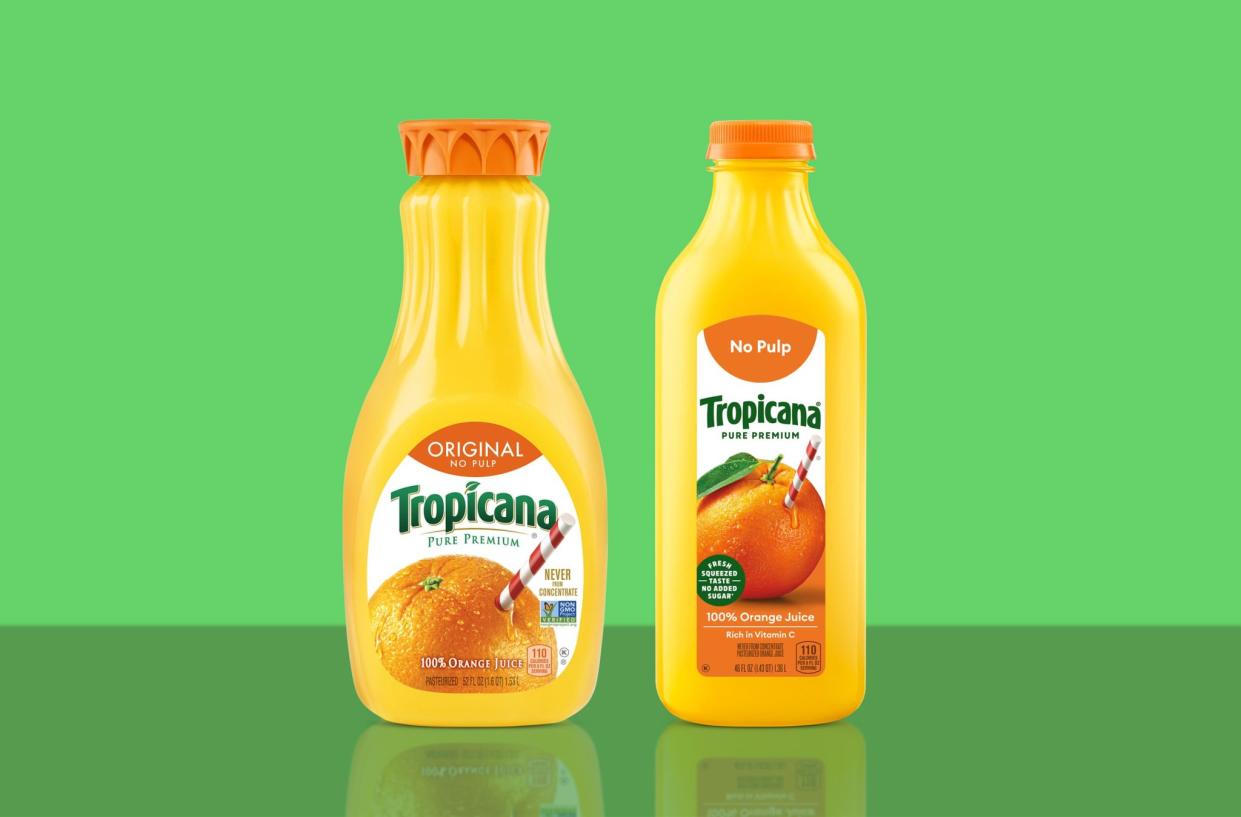
This time around, orange juice drinkers are wary of shrinkflation, or product sizes reducing while prices stay the same. Indeed, while Tropicana has set the price of its new bottles at $3.99, about 70 cents cheaper than its old design, the slim bottles are still more expensive per ounce than the older ones in some retailers. At Walmart, the new 46-ounce bottles cost 7.7 cents per ounce, while the 52-ounce bottles retail for 7.6 cents per ounce. Consumers have taken notice of the alleged shrinkflation.
“Done with Tropicana. Classic Shrinkflation,” one BlueSky user said. “Last time it comes into this house. Time to stand up and let these big corporations know that we actually DO count. Sickens me.”
Tropicana responds to shrinkflation allegations
Shrinkflation has been a growing concern for consumers since 2022, when brands tried to hide the impact of inflation by strategically reducing package sizes instead of hiking up prices. Snack brands—even favorite cereals—have been the worst alleged perpetrators of shrinkflation, with Doritos bags shrinking from 9.75 ounces to 9.25 ounces, and “family-size” boxes of General Mills’ Cocoa Puffs and Cinnamon Toast Crunch contracting from 19.3 ounces to 18.1 ounces over the course of a few months in 2022.
But it’s not the social-media ire that should concern Tropicana, but rather the threat of sales being washed down the drain. After all, the last redesign that soured customers resulted in a nearly 20% sales loss in just a few months.
Tropicana, which PepsiCo sold in 2021 to private equity firm PAI Partners, is now owned by joint venture Tropicana Brands Group, meaning its sales data are not publicly available; but according to consumer research firm Circana, Tropicana sales plummeted immediately after the switch, dropping 10.9% in August, and 19% by October, CNN reported.
“Consumers voting with their wallets is the most powerful and underrated form of protesting. Incredible,” one user commented on Reddit.
Tropicana Brands Group told Fortune that according to third-party data, sales are returning to normal levels, though it acknowledged it takes time for consumers to adapt to packaging changes. The company made the change—informed by customer feedback—to make the bottle easier to pour and store, as well as to produce a more sustainable cap using less plastic.
“Anecdotally, we are hearing from many that the changes better suit them and optimize their experience with our product,” a Tropicana Brands Group spokesperson told Fortune in a statement.
Tropicana’s sour customers
Tropicana will hope customers’ bitterness about the change sweetens, so as not to repeat the fallout of its redesign efforts 15 years ago. In early 2009, the juice brand switched its packaging from displaying an orange with a straw in it to an image of a tall glass of juice. Customers panned the change, complaining the bottles looked generic.
“Do any of these package-design people actually shop for orange juice?” one angry email-writer wrote to the company at the time. “Because I do, and the new cartons stink.”
The design tweak, estimated to have cost Tropicana $35 million, had a seismic shift on the juice industry. Not only did Tropicana unit sales plummet 20% from Jan. 1 to Feb. 22 following the rebrand, but dollar sales dropped 19%. Tropicana competitors Florida’s Natural and Minute Maid saw double-digit unit sales boosts in the same two-month period. Tropicana reverted to its original package soon afterward.
Peter Arnell, the designer behind Tropicana’s rebrand—who was also responsible for Pepsi’s metaphysical 27-page redesign outline in 2008 invoking the Mona Lisa and Earth’s gravitational pull—justified the 2009 packaging change. He questioned why the orange, but never the juice, was previously featured on Tropicana’s packaging. The new design’s orange twist cap “implied ergonomically” the squeezing motion that is required in making juice—and, in Arnell’s eyes, so much more.
“‘Squeeze’ maintains a certain level of, I guess, power when it comes to this notion emotionally about what squeeze means,” he told AdAge in 2009. “Like, ‘my squeeze’ or ‘give me a squeeze,’ or the notion of a hug, or the ideas behind the power of love and the idea of transferring that love or converting that attitude between mom and the kids, right?”





